
Transgender employees onboarded
Recognised by World Steel Association for Health & Safety Excellence
Adopted
SE
Our people have always been one of our most valued stakeholders and key differentiators. One of the Strategic Enablers of our Strategy 2030 is to become the ‘Best Workplace in Manufacturing Sector,’ which has led us on a path of new possibilities, requiring us to re-define our people agenda through collaborative actions.
The foundation of long-term value creation at Tata Steel rests on its philosophy of participative management between the management and the Union. Tata Steel has a culture of working together through joint consultations between the two and has a very strong commitment towards community development. Our people practices have enabled us in creating an environment of collaboration and connect, which has aided us in achieving industrial harmony for over 93 years. Continuing our people-centric philosophy, we successfully completed the people integration of Tata Steel BSL Limited (now known as Tata Steel Meramandali) during the year.
The COVID-19 pandemic had thrown at us a new set of challenges and we continue to evolve our people practices supporting our employees. We pursued vaccination of our workforce and their family members, and achieved a vaccination coverage of over 99% of our own and contract employees across all locations and businesses. The Covid Family Protection Scheme was introduced to support the families of employees who succumbed to the virus. The pandemic brought digitalisation into sharp focus, with many projects being implemented to ensure employee safety and well-being, ushering a new way of working through data-driven decision-making.
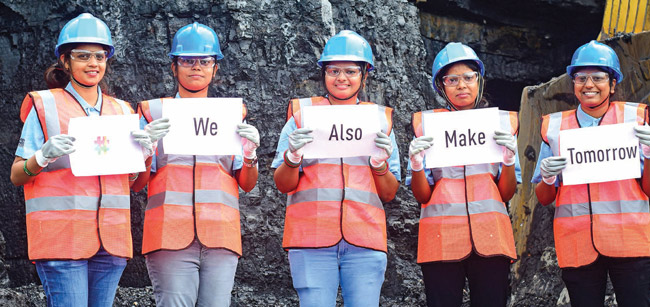
Fostering a diverse and inclusive culture
In FY 2021-22, Shavak Nanavati Technical Institute (SNTI) completed 100 glorious years, making its mark as an institution that has been shaping generations of talent for Tata Steel. Multiple interventions for skill building of employees were undertaken during the year. Nine new schools of excellence were launched in the prioritised areas and a new batch for an evening diploma program was also introduced. Almost 1,000 cadre trainees spent significant time at SNTI, learning and developing themselves to become industry-ready. Mechanisms have been put in place to ensure relevance of curriculum to the changing business needs. Focus was given to upskill/reskill the large pool of vendor employees through specific initiatives like ‘VSD 2.0’ and ‘Super 40’. Imbibing the mantra of ‘agility’, the Learning and Development (L&D) team could ensure that the pandemic did not impact the learning of individuals. In fact, adoption and optimum use of digital technologies helped accelerate anytime-anywhere learning mechanisms. This is manifested in the fact that in FY 2021-22, the ‘Training Days Per Employee’ KPI jumped to 11.51 (~80% increase over the FY 2020-21 figure of 6.38). L&D assets and services could also be monetised to the tune of `15 crore in FY 2021-22.
Improving productivity is crucial for remaining competitive. Overcoming the challenges posed by subsequent waves of COVID-19, we continued our productivity improvement journey through various focussed initiatives. We strived to achieve benchmark performance with initiatives such as ‘Sunehre Bhavishya Ki Yojana 2.0 (SBKY 2.0)’ and ‘Internal Talent Bank’ for managing redundancy. Agility and technology continued to play a central role in improving organisational performance with our productivity reaching 854 tonnes/employee/year. During FY 2021-22, we undertook several initiatives, such as throughput improvement, cycle time reduction, operational excellence projects, along with efforts to identify redundancy. Our organisation design simplification efforts enabled seamless integration of Tata Steel BSL with the Company, thus contributing to our productivity performance for FY 2021-22. We made significant progress in simplifying our processes and systems to make them more efficient and effective. Employees were also sensitised on productivity improvement through various programmes.
Employee productivity per employee/year
Diversity within our workforce is of paramount importance as it enhances our overall capabilities, promoting a culture of innovative thinking. Diversity & inclusion is a way of life to ensure fair and equal opportunity for all employees. Our MOSAIC - a diversity & inclusion wing covers four aspects, gender, person with disabilities (PwDs), LGBTQ+, and different sections of society (e.g., Affirmative Action Community).
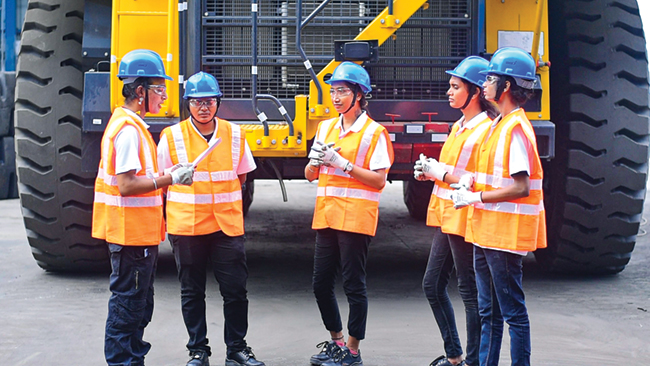
Onboarding and inclusion of transgender employees
Tata Steel is committed to improving the quality of life of the communities where it operates globally based on the ethos of the Tata Group - ‘Leadership with Trust’. We are committed to respecting, protecting, and upholding the human rights of all our rights-holders across our value chain.
The Tata Code of Conduct is the comprehensive document that serves as the ethical roadmap for Tata employees and companies. It provides the guidelines by which the Tata Group conducts its businesses. A core principle in the Tata Code of Conduct is ‘Respecting the human rights and dignity of all stakeholders.’
The rights-holders have access to structured grievance communication channels across all our sites and value chain.
In March 2022, Tata Steel adopted the Business and Human Rights Policy and institutionalised a governance structure for the deployment of the policy. The policy is aligned to the Universal Declaration of Human Rights, ILO Declaration on Fundamental Principles and Rights at Work and the United Nations Guiding Principles on Business and Human Rights. The objective of the policy is not only to remediate any concerns regarding human rights but also to have a proactive due diligence approach to identify vulnerable areas for protection. A newly constituted Apex Business and Human Rights Committee chaired by the Company’s CEO & MD oversees deployment of the policy.
Our commitments under the Tata Steel Business and Human Rights Policy state:
Tata Steel shall recognise individuals and communities as holders of human rights and shall:
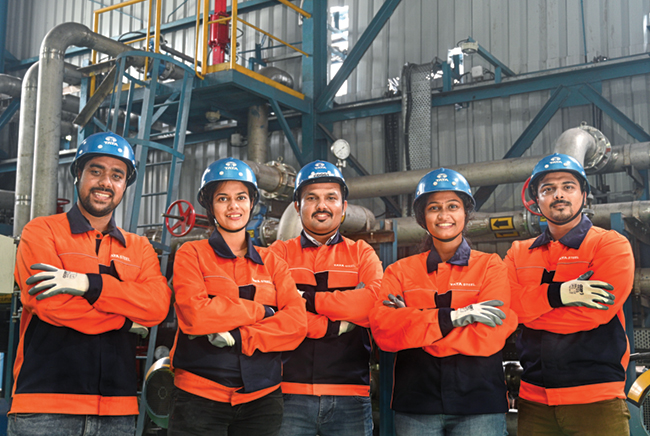
Committed to upholding human rights
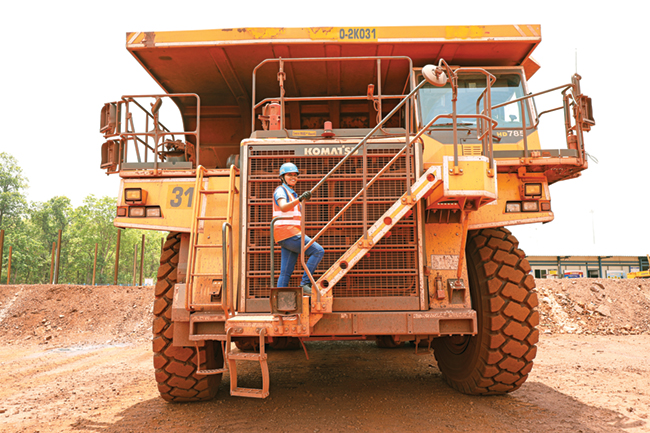
Women@Mines initiative to drive women participation in the manufacturing sector
Tata Steel defines a rights-holder as a person whose human rights can potentially be impacted by the operations of the organisation and, accordingly, the following six categories of rights-holders have been identified, namely:
We have identified 14 human rights issues as priorities to be addressed across the value chain:














Our safety governance structure is driven by the Safety Health and Environment Committee of the Board and the Apex Safety Council. The Safety Excellence Journey (SEJ) Committee, under the guidance of the Apex Safety Council, works for policy formulations. Their directives are cascaded through the six Apex Safety sub-committees, which further cascades to Divisional Implementation Committees and Area Implementation Committees. Execution of leadership directives is ensured through robust review mechanism across the organisation. We have been working on six safety strategies – build safety leadership capability at all levels to achieve Zero Harm, strengthen deployment of contractor safety management standards, improve competency and capability for hazard identification and risk management, improve road and rail safety, excellence in process safety management, and establish industrial hygiene and improve occupational health. Leveraging digital and technology in safety has also been identified as a key long-term initiative. The enablers of different strategies are embedded with the executive’s annual performance contract and are linked with remuneration. The overall objective is to achieve global benchmark levels by FY 2024-25 and Zero Harm by FY 2029-30, ushering a new way of working through data-driven decision-making.
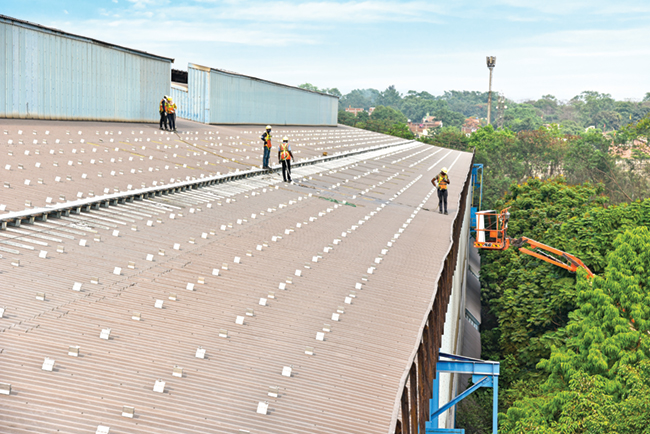
Driving a culture of Safety
To bring a holistic approach towards the adoption of digital and technology and enable Tata Steel’s Safety Excellence Journey to achieve the overall objective of Zero Harm, an apex Digital and Technology Safety Sub-committee was formulated with a two-pronged approach:
Focus on the dissemination of learning from safety standards continued during the year, with a total of 44 safety standards simplified, and e-learning modules developed, inculcating knowledge about safety standards among the workforce. In FY 2021-22, the organisation-wide deployment of the learning and recommendations from fatalities over the past 15 years was continued with an endeavour towards achieving Tata Steel's Safety vision of Zero Harm. As many as 100 recommendations generated from the past fatal incidents have been implemented at 5,325 identified locations.
The second cycle of ‘SHE Excellence Awards’ was held through virtual platforms to reinforce positive safety behaviour.
At our UK operations, we carried out over 140 leadership tours to focus on machinery and workplace equipment safety across our sites and offices.
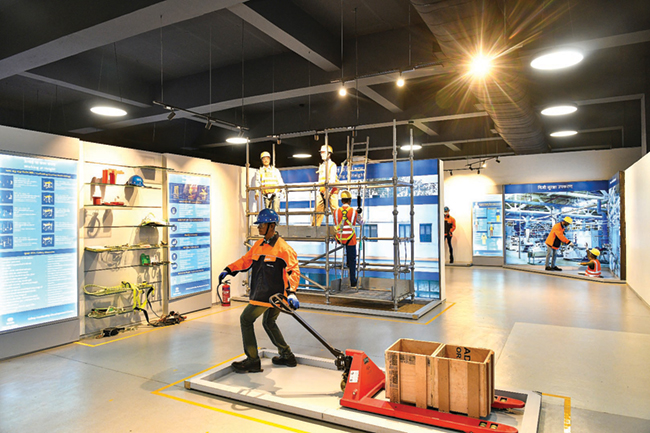
Safety Leadership Development Centre, Tata Steel Jamshedpur Works
The need to deploy competent workforce for its technology-driven operations also requires Tata Steel to constantly enhance their competency and capability on various safety standards. A workforce of 41,292 (employees-4,152, contractors-37,140) was trained on various safety standards at the Safety Leadership Development Centre (SLDC) during the year.
Also, 71% of Tata Steel’s employees have been trained on the simplified safety standards in Phase-1 e-learning assignment, and 55% in Phase-2 e-learning assignment.
Cross-functional assessment on 5S and Visual Workplace Management (VWM) across Tata Steel was rolled out to mitigate shopfloor risks and create awareness among workforce about the importance of organising spaces so that work can be performed efficiently, effectively, and safely.
Going forward, Tata Steel will train and certify its entire workforce at SLDC at all major manufacturing locations and upgrade facilities at its Safety Excellence Centre by introducing practical safety training modules.
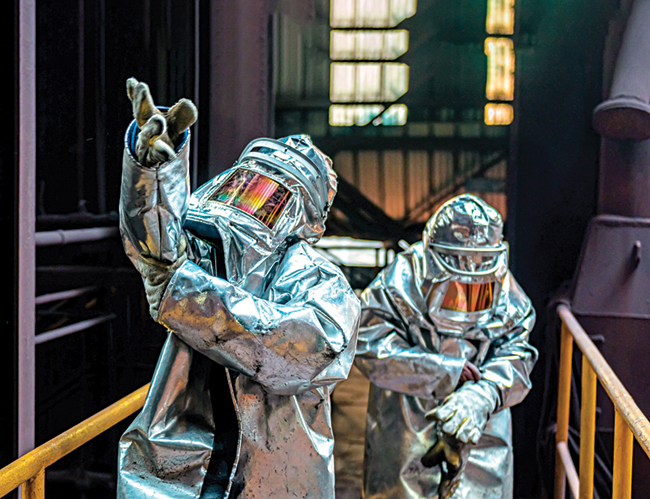
Committed to Zero Harm
Contractor Safety Management Standard (CSMS), which governs contractor safety at Tata Steel, has established guiding policies and procedures on safety responsibilities for contractors and their employees. The deployment of CSMS now includes within its scope all stockyards, Steel Processing Centres (SPCs) and Tata Steel Group Companies.
This year, a behaviour-based safety program, ‘GHAR SE GHAR TAK,’ has been designed and developed to improve behaviour and discipline of contract workforce, as families play an important role for the employees to work stress-free and behave safely at the workplace as well as outside or at home.
In the past year, over 150 skill sets were identified for certification, and classroom modules and e-learning modules were developed, through which 100% deployment of skill certified workforce entering Tata Steel Jamshedpur, Tata Steel Kalinganagar and Raw Material locations was ensured. This skill certification program has also been extended to Tata Steel Meramandali.
Upgrading skills of contract workmen from Silver and Gold to Platinum, and development of model CSM workplaces across locations including SPCs/Business partners, are intended to improve the contractor safety management within Tata Steel. Strengthening the contractor safety management standards at Tata Steel Meramandali and Tata Steel Long Products Limited will be one of the imperative focus areas. Specialised training programmes for vendor employees on identified equipment and processes (Vendor skilling 2.0 and multiskilling) are aimed at creating ubiquity in safety standards across the organisation and universalisation of best practices. Reward and recognition systems for contract workforce will also be introduced in FY 2022-23 to reinforce positive safety culture among the workforce.
Process Safety Management focusses on eliminating incidents with the potential to result in multiple injuries/ fatalities, as well as causing substantial economic, property and environmental damage, both within the steel manufacturing units and across surrounding communities. The endeavour to make it a ‘way of life’ was initiated in 2016 with the Centre of Excellence (CoE) framework being embedded in two manufacturing units at Jamshedpur. It has been rolled out in 43 departments and the existing Maintenance Management System has been benchmarked to Tata Steel Europe’s Asset Management System to develop and roll out an integrated Asset Management Framework for Tata Steel.
A tableau-based, online Process Safety Performance Indicators (PSPI) dashboard was introduced in 2020, incorporating all process safety-related lag and lead indicators. All available IT systems (SAP, ENSAFE, Process Data, L1/L2 systems) with their various process safety parameters were integrated into the common dashboard, business rules formulated against them, and real time alerts were made key components. The online PSM dashboard has induced timely maintenance of Process Safety Critical Equipment (PSCEs), leading to reductions in failure of critical equipment. It has not only helped reduce Red and Yellow category process incidents, but also injected a cultural change in the way line managers think about managing deviations in process parameters. The Process Safety School of Excellence, a 3-tier capability development (learner, practitioner, expert) system, has been developed to enhance process safety competency of employees.
High potential process incidents over FY 2020-21
Overall PSM maturity assessment score
Approval cycle time of management of technological change
PSM will be rolled out in the remaining high hazard departments of Tata Steel Meramandali and Tata Steel Long Products Limited along with a PSM audit process to check maturity of its deployment. An IT system will be developed for predictive/prescriptive model for process safety incidents, which will enable real time visualisation of risk movement through active barrier’s health assessment. Competency development through the Safety School of Excellence will be continued for employees at all locations.
At our UK operations, we have created a safety app to increase engagement. We now use drone technology, virtual reality and fatigue testing in critical process safety areas to help reduce risk.
Safe and efficient movement of raw materials and finished goods via both rail and road is the mainstay of inbound and outbound logistics. While initiatives in the past focussed on improving road and rail safety processes, in FY 2021-22, the focus was on implementation of technological initiatives for road and rail safety improvement along with continued implementation of COVID-19 standard operating guidelines for business continuity. Modified seating arrangements in mass transport facilities were reintroduced during the onset of the second and third wave of COVID-19. Sanitation of public transport within the plant was ensured after each trip as well as IT-enabled alerts were triggered through CCTV feeds, enabling proactive action through the Safety Surveillance Centre.
Among planned improvements undertaken during the year, digital interventions for real-time monitoring and recording of unsafe acts/conditions on roads through an Automatic Number Plate Recognition (APNR) System, achieved the desired improvement in behavioural issues of road users. Training modules, focussed on competency development of heavy vehicle operators and loco pilots, were introduced with the support of the learning and development team. The Drivers Fatigue Monitoring System (DFMS) was extended to all locations including Tata Steel Meramandali, which again, yielded positive results in heavy vehicle safety management at night. Risks associated with overturning of heavy vehicles, derailments of wagons and dumper toppling, are being addressed through deployment of anti-tilt switch, smart signalling system and effective interlocks for raised dala condition in dumpers; 100% implementation of locking mechanism for Safe Load Indicator (SLI) in pick and carry mobile cranes has been done to prevent crane toppling incidents across locations.
The key to enhance road safety and be future-ready is deployment of technological interventions such as anti-tilt switches, effective interlock system for dumpers in dala-raised condition along with strengthening the deployment of DFMS across locations of Tata Steel. Planned improvements in road infrastructure at Tata Steel Jamshedpur, Tata Steel Long Products Limited and Tata Steel Meramandali are to continue along with behavioural safety training programs for heavy vehicle operators.
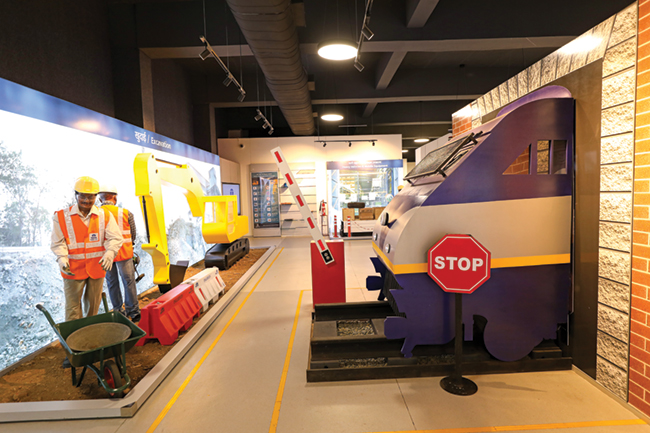
Safety is a way of life at Tata Steel
Tata Steel implemented a comprehensive industrial hygiene program which included identification of occupational health hazards and risk analysis, assessment of actual exposure through hazard quantification, and implementation of hazard control measures to maintain minimum exposure level and to reduce occupational health-related risks. We also conducted ergonomics risk assessment and implemented related control measures at Jamshedpur Works, in order to achieve the best mutual adjustments of employees and work. We have conducted regular COVID health screenings of employees, contract employees, truck drivers and food handlers, to mitigate the effect of the pandemic at workplace.
At our Thailand operations, we supported employees, their families and the contractors with COVID-19 vaccines during the year with >97% of employees and contractors vaccinated with a minimum of 3 doses.
Tata Steel intends to implement a comprehensive physical and mental well-being digital program across locations, reducing and controlling lifestyle diseases and mitigating ergonomic risk factors via assessments and control measures. Our focus on COVID-19 testing and raising awareness regarding the virus, remains undeterred.